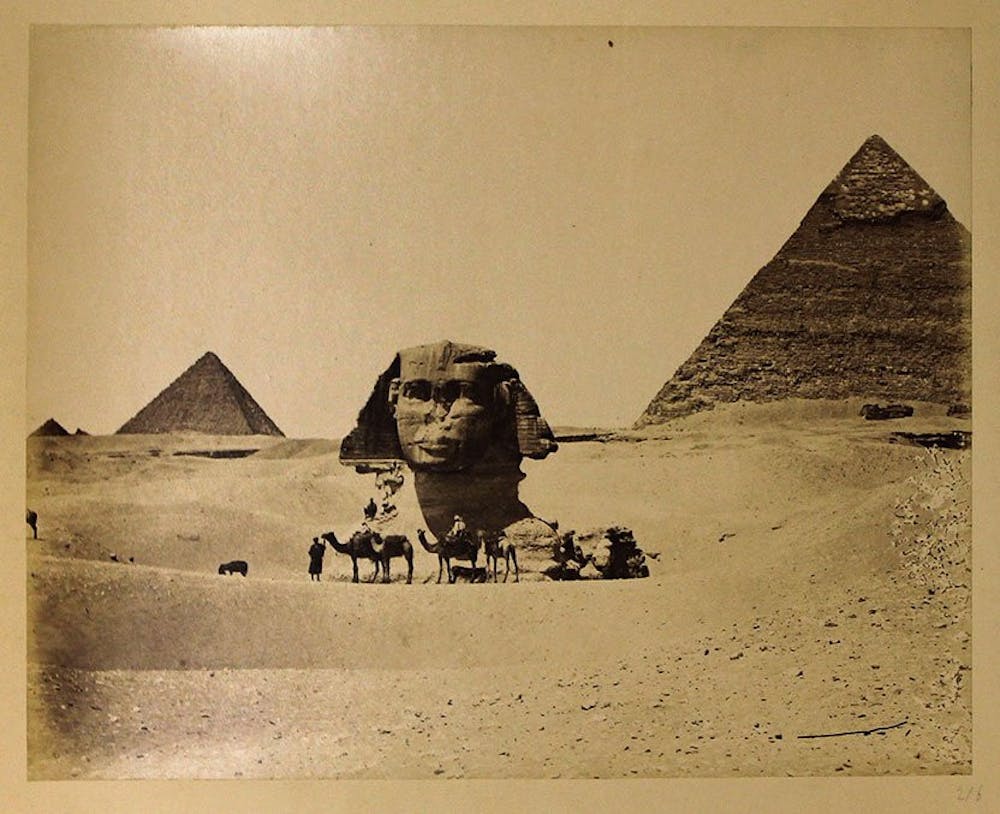Nestled in the south corner of campus, the Middlebury College Museum of Art (MCMA) was buzzing this Thursday, as students, faculty and visitors gathered in celebration of the museum’s two special exhibitions, “Tossed: Art from Discarded, Found, and Repurposed Materials,” and “The Light of the Levant: Early Photography and the Late Ottoman Empire.” The exhibition kickoff gave guests the chance to enjoy a cocktail while perusing the collections, offering a glimpse into the museum’s role as a cultural center on campus.
“The Light of the Levant” opened on Sept. 5 and will be on display through Dec.10. Running the gamut of political, economic and ideological themes, the exhibit transports its visitors to a time when imperial thought was a strong through line in artistic culture, while also documenting photography’s technological advances from the 1840s through the 1930s. Spanning nearly a century, “The Light of the Levant” covers early photography’s connection to imperialism and a growing tourist industry, poignantly illustrating photography’s political and commercial influences through well-organized and perceptive wall labels, some of which were contributed by students in Visiting Assistant Professor of History of Art and Architectural Studies Sarah Rogers’ spring 2023 seminar, “Orientalism and the Visual Arts.”
The exhibition begins with the French photographer Girault de Prangey’s stills of the Middle East captured by his daguerreotype camera. It is roughly chronological, concluding with work from Karimeh Abboud, a self-proclaimed “lady photographer” whose portraiture and postcards give light to Palestinian communities under the British Mandate. The last portion of “The Light in the Levant” comprises a collection of Abboud’s postcards, marking the beginning of mass-produced photography. Along with Aboudd’s postcards of Galilee, the River Jordan, Nazareth and Jerusalem are photographs of the Parthenon, the Temple of Athena Nike and other snapshots of iconic Ancient Greek structures and locations.
“The Light of the Levant” captures both the geographic and the technologic expansiveness of the late Ottoman Empire with impressive coherence. Co-curators Pieter Broucke, dean for the arts and professor of history of art and architectural studies, and Rogers combined her expertise in the history of photography with Broucke’s knowledge of pre-modern architecture to create a remarkable final product. “It was a wonderful collaboration between our individual research interests and between the collection at the Museum and Special collections,” they both noted.
Next to “The Light of the Levant” in the museum is “Tossed: Art from Discarded, Found, and Repurposed Materials.” “Tossed” is a nontraditional exhibit —one in which gasoline containers become Benin masks, a thrifted military jacket transforms into a life-size figure of an angel and a breadboard serves as a political commentary on oppression and resistance. The exhibit opened on May 26 of this year, showcasing the creativity of artists repurposing a diverse range of frequently discarded materials in eighteen selected works.
Printed on the wall are a number of quotes from the featured artists. A statement from artist Duke Riley reads, “I knew, when I was a kid, that I either wanted to be a garbage man, an artist or a thief. And I think I became all three.” This sentiment gets to the heart of “Tossed,” and art’s relationship to originality, heritage, and an artist’s creative ability. The exhibit demonstrates the artists’ skill of connecting two seemingly unrelated things and granting often neglected material fresh, imaginative meanings in relation to a new concept.
Attendees at the opening reception included students from the art history course “Museum Studies: Exhibit Design,” taught by the college’s museum designer Ken Pohlman this past winter term. Christopher Fridlington ’24, a member of Pohlman’s class, mentioned how rewarding it was to see the efforts made by the class come to life. Curated by Pohlmanwith assistance from museum director Richard Saunders, former chief curator and director of engagement, diversity, equity and inclusion Jason Vrooman and Breadloaf alumna Jennifer K. Brown MA ’94, along with student curators in Pohlman’s course, “Tossed” is a must-see.
Despite their differences in time period, subject and themes, each exhibit is striking in its own right and both serve as powerful displays of the combined achievements of artists, curators and student contributors.
Catherine Goodrich '24 (she/her) is a Senior Arts and Culture Editor.
Catherine previously served as an Arts and Culture editor and Staff Writer. Catherine is an English and Film double major hailing from Birmingham, Alabama. She is the prose editor for the Blackbird Literary Arts journal and works concessions at the Middlebury Marquis where she has developed a love for trivia and making nachos.




